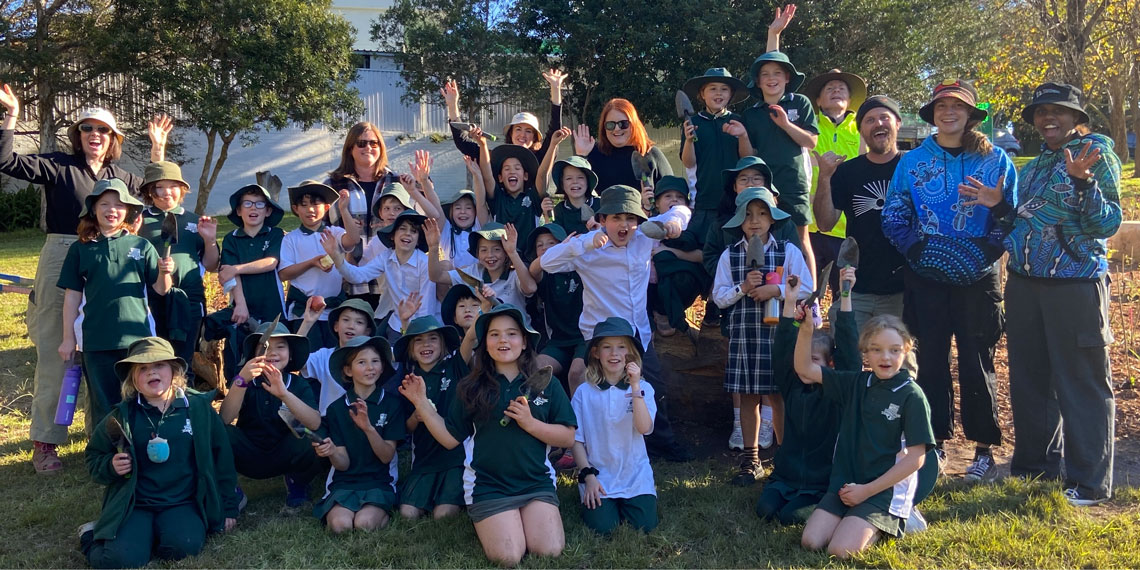Tiny Forest West Pymble

What is a Tiny Forest?
Tiny Forests are densely-packed patches of local native bushland around the size of a tennis court. These urban wildlife oases have the potential to help us fight pollution and global warming while creating a place for community to gather, learn about and interact with nature.
Tiny Forests use the established Miyawaki planting method that includes soil enrichment, diverse local indigenous plant selection and a dense planting structure. Tiny forests may be small, but they punch above their weight, at least ecologically speaking. They grow up to 10 times faster than natural bushland.
Tiny Forest map
 |
Map key
1. Control plot - Planting completed.
Approximately 60m2 Sydney Turpentine Ironbark Forest species used to compare tree growth rate.
2. Tiny Forest - Planting completed.
Approximately 200m2 Turpentine Ironbark Forest species providing ecological and social benefits for the community.
3. Outdoor learning area - Sandstone seating completed.
|
Why West Pymble?
The site is approximately 320 square metres, including an outdoor classroom and control plot. The Village Green will still be available for people to kick a ball, walk the dog or enjoy a coffee in the sun.
One of the key criteria for Council was a space where the Tiny Forest wouldn’t impact existing users. You can see from the image above that it only takes up a small area and screens the oval from the petrol station improving the amenity for all.
How are the sites selected?
- Approximately 500m2 is needed for planting plus space for deliveries/machinery. The forest must not be narrower than 4m at any given point.
- No underground infrastructure: soil typically excavated to 1m depth.
- No overhead infrastructure: trees could grow to 20m+.
- Water point/access for a vehicle and water bowser.
- Does not cause obstruction to people’s right of way (the forest becomes very dense without a specific pathway).
- Within an urban setting, easily accessible to local community users
- Should not be designated as sensitive in any way, eg. Ramsar site
- Should be an open area (we do not want to remove trees to plant new ones!), scrub or low vegetation is fine.
- Forest should be as compact as possible and is not suitable for using as hedging.
- Paths and open classroom can be included in design.
- Forest can be fenced while the site is being prepared (for safety) and with logs or other natural fencing for at least the first 2 years.
Who is involved in the project?
Council is working with Earthwatch Australia in partnership with Bupa to establish our first Tiny Forest.
Established in 1982, Earthwatch Australia is a citizen science organisation that engages communities in scientific research to protect landscapes and wildlife. The Earthwatch Tiny Forest program creates a network of outdoor classrooms and living labs where school children and communities monitor biodiversity, growth rates, carbon storage, thermal comfort, water infiltration, soil condition, social benefits and learn about the importance of local biodiversity. Earthwatch leads the Miyawaki Research Network, a global coalition studying the benefits of Tiny Forests.
Read more "Playbook for Urban Biodiversity" (2024) and "Let’s Scale Up! Urban Greening in the Private Realm: Engaging and motivating community" (2022).
Earthwatch is currently working with Councils at Lake Macquarie, Adelaide and Monash. Tiny forests have also been built all around the world, but the Ku-ring-gai Tiny Forest will be the first in Sydney!
Who is paying?
Earthwatch Australia is funded by philanthropy, corporations and government. In September 2023, Bupa's "Move Month" generated $1M for urban regeneration, with Earthwatch receiving funding as one of four environmental organizations. Earthwatch's Tiny Forests program prioritises education, citizen science and biodiversity outcomes. Bupa's contribution will fund forest assets and related education and research programs at two sites.
What plants will be used?
We are using plant species found within the Sydney Turpentine-Ironbark Forest (STIF), a Critically Endangered Ecological Community.
Council’s nursery is providing approximately 980 native plants and the Indigo Native Nursery are providing a further 490 native species. Nursery volunteers have propagated and cared for these seedlings collected from local populations. Ensuring the Tiny Forest is suited to Ku-ring-gai’s conditions and the continuation of wild plants.
Get involved
We encourage the local community to help plant, maintain and conduct important research at these sites, to better understand the benefits these tiny but mighty native forests provide. The results will be monitored with the help of citizen scientists and local schools.
Become a Tree Keeper
We are seeking volunteers of all ages to help us look after our Tiny Forest. No experience necessary! You will need to visit the Tiny Forest a handful of times a year to do basic maintenance. You can also help collect data through citizen science surveys.
We will provide you with all the information and tools you need. Register your interest by emailing hello@earthwatch.org.au.